Q: We have experienced high populations of annual bluegrass on our bermudagrass fields here in Oklahoma the last few years. I would like to use chemical control this year, but I am not sure of my options considering our long, cold winters. What are your thoughts?
A: I believe annual bluegrass (Poa annua) has to be considered among the top five weeds on athletic fields. It withstands low mowing and cold conditions, and prefers wet, compacted soils. It produces huge numbers of seeds that begin germinating in late summer and may continue to germinate throughout the fall, winter and spring. Although classified as an annual, weed scientists have discovered perennial biotypes. Scientists have also documented annual bluegrass resistance to multiple herbicides.
It is hard to talk about weed control without first mentioning cultural practices. Although cultural practices may not provide adequate weed control, they can still impact weed density and your ability to use specific chemicals for weed control. Manage your cultural practices to grow the thickest, healthiest stand of turfgrass possible. Consider if you must overseed in the fall, as this will have a significant influence on available chemical control options. There are significantly more pre- and post-emergence control programs available for non-overseeded fields.
When overseeding, timing of establishment will come into play when considering your options. For example, commonly used pre-emergence products such as pendimethalin, prodiamine, dithiopyr, and oxadiazon (granular formulation) applied in the fall may effectively control annual bluegrass, but they must be applied two to four months before overseeding (depending on product and rate); otherwise, the overseeding grass can be heavily damaged. Super early pre-emergence applications may also miss a substantial amount of late-germinating bluegrass.
Post-emergence programs have the same issue in that many annual bluegrass post-emergence products cannot be applied to ryegrass, and some can only be applied to totally dormant bermudagrass. Some products can be applied days to a few weeks before overseeding without any injury to ryegrass, whereas others cannot. For example, in the sulphonyl herbicide family, foramsulfuron, rimsulfuron, and sulfosulfuron can be used to control annual bluegrass close to overseeding but trifloxysulfuron needs be applied at least three weeks before seeding.
The last chemical control strategy that is often used with non-overseeded fields is the use of non-selective herbicides. In Oklahoma, as with many other areas that grow bermudagrass, total dormancy of the turfgrass is expected. Once the bermudagrass is dormant, non-selective products such as glyphosate, glufosinate or diquat may be used. There are also benefits to mixing products with a different mode of action in the tank to increase activity while also managing to prevent herbicide resistance. Some managers may also mix pre-emergence products in with post-emergence products to get longer-lasting control.
Cold winters, as you suggested, have implications with picking a chemical control program. In the transition zone of the United States, or in regions north of the transition zone that are using bermudagrass, winterkill or winter injury is a reality. For example, the pre-emergence herbicide indaziflam provides very good and long-lasting control of annual bluegrass. However, it has up to a 12-month overseeding or sprigging interval, and a six- to eight-month sodding interval. In an area that experiences winter bermudagrass damage, waiting that long before re-establishing a turfgrass can be a huge issue. Product, application rate and timing, as well as residual activity, must be given strong consideration in your environment.
There are far more products and use-options available to you than those mentioned in this article. With all the factors, products and scenarios to consider, I encourage you to talk with your state’s turfgrass specialist or weed scientists to help you figure out the best plan to use in your situation. This is also another great reason to attend local SFMA meetings and learn more about the experiences of other field managers in your area.
Grady Miller, Ph.D.
Professor and Extension Turf Specialist
North Carolina State University
Questions?
Send them to Grady Miller at North Carolina State University, Box 7620, Raleigh, NC 27695-7620, or e-mail grady_miller@ncsu.edu
Or send your question to Pamela Sherratt at 202 Kottman Hall, 2001 Coffey Road, Columbus, OH 43210 or sherratt.1@osu.edu

